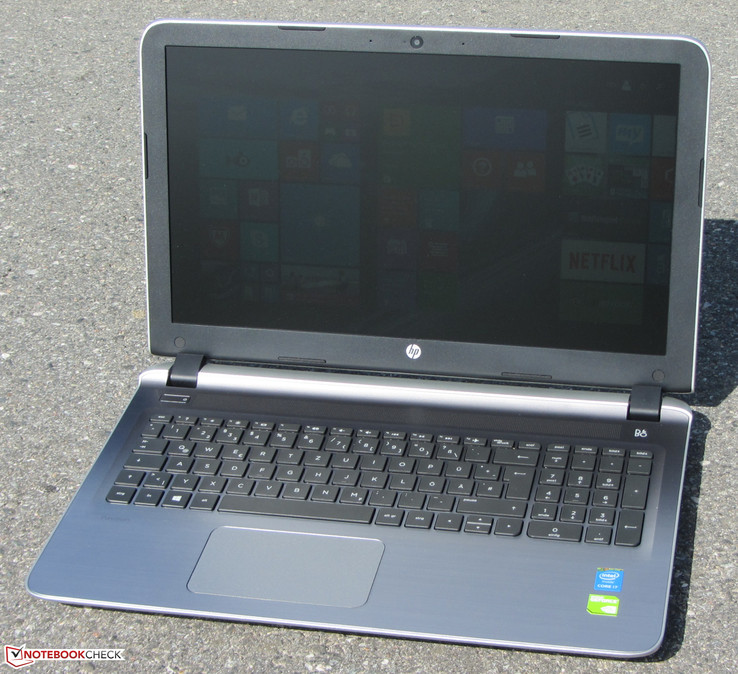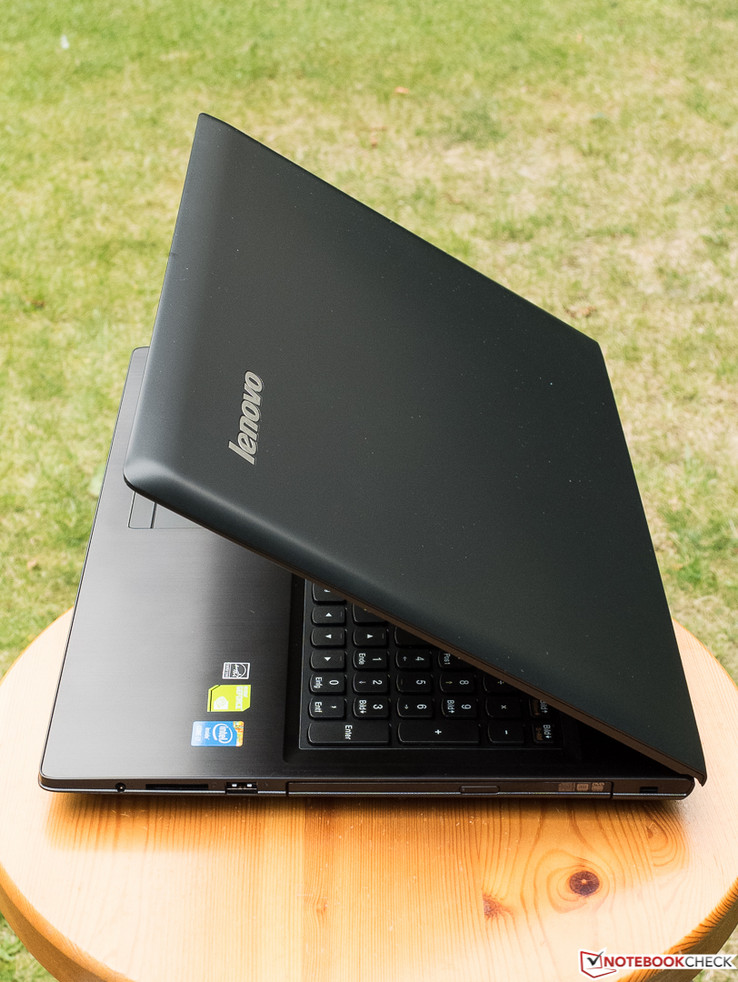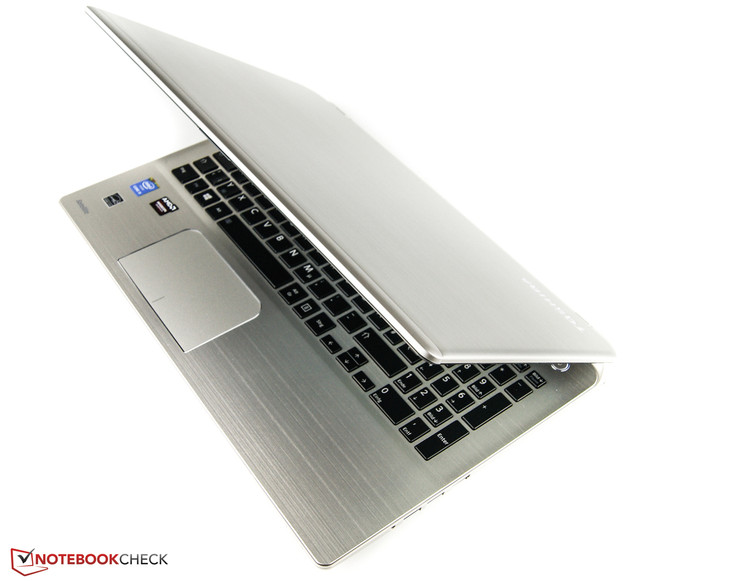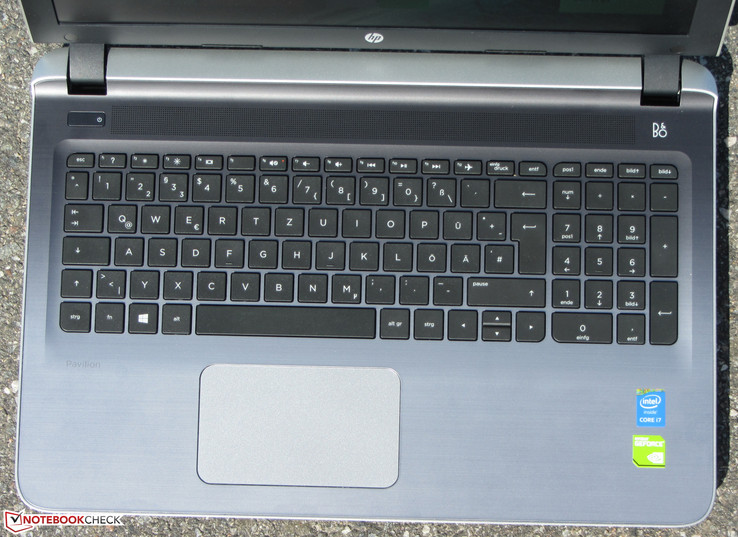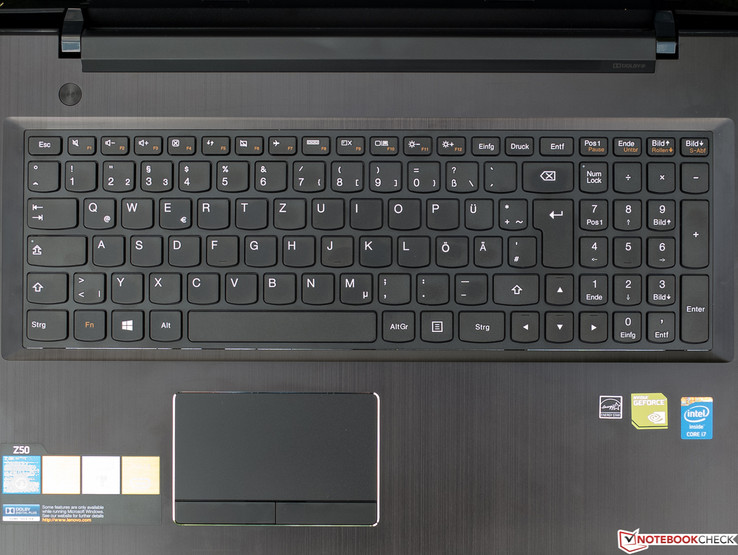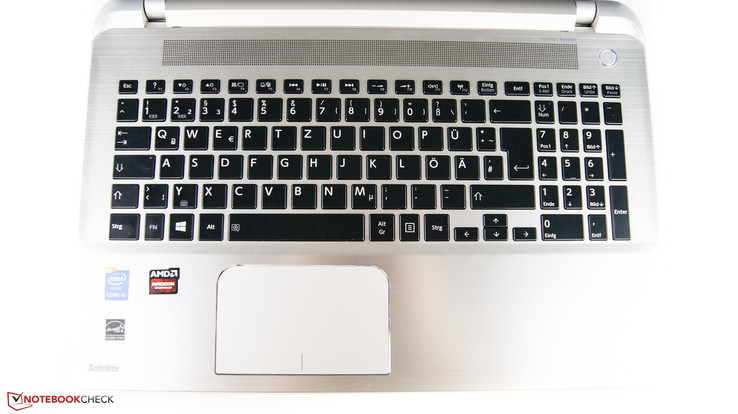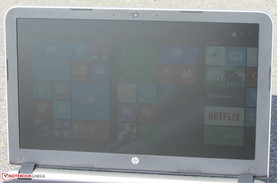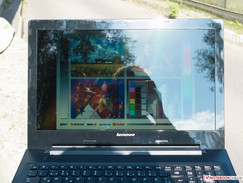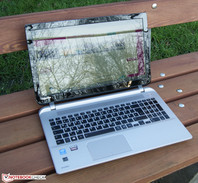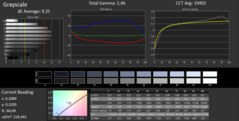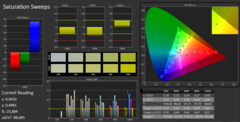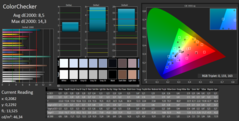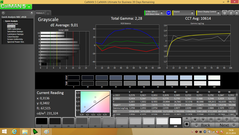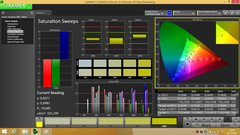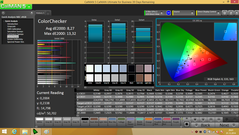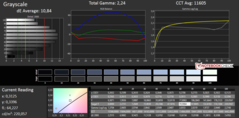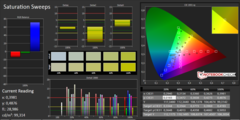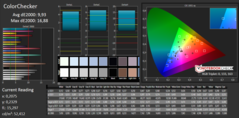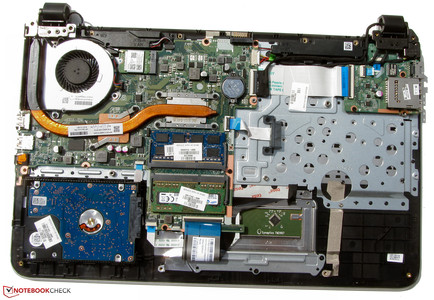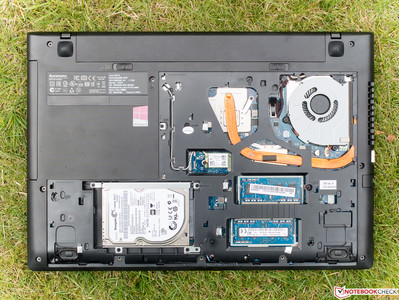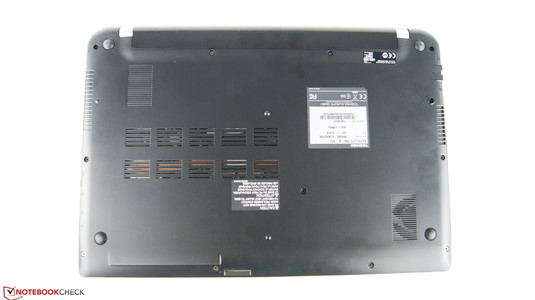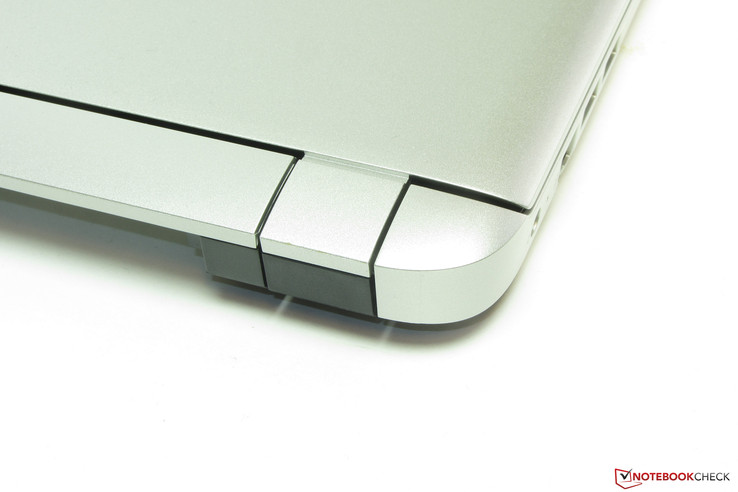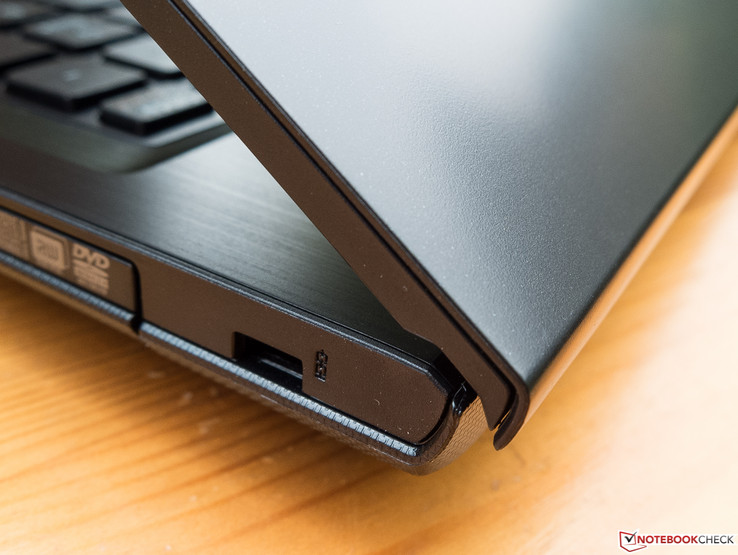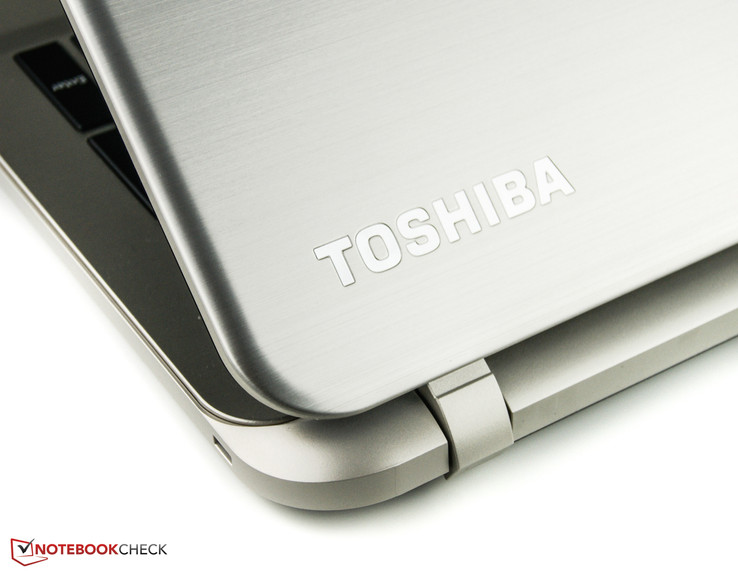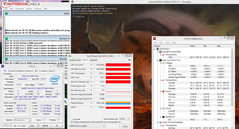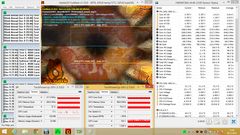Face Off: HP Pavilion 15 vs. Lenovo IdeaPad Z50 vs. Toshiba Satellite S50

Convertibles, detachables, and Ultrabooks -- oh my! Users looking for a more down-to-Earth notebook without the added bells and whistles are finding more and more gimmicky multi-mode solutions and fewer "normal" notebooks to choose from.
Fortunately, many standard mainstream notebooks have yet to make the transition to touchscreen, swiveling lids, or other novel bullet points. For this Face Off, we'll compare the popular and more affordable HP Pavilion 15, Lenovo IdeaPad Z50, and Toshiba Satellite S50 to see if these no-frills notebooks are still worth the time.
We encourage users to check out our dedicated review pages below for more data and detailed analyses of each of the three models. This comparison is by no means a replacement, but a condensed aid for those on the fence.
HP Pavilion 15 2015 Review (Pavilion 15 2014)
Lenovo IdeaPad Z50-70 Review (IdeaPad Z50-75 w/ Intel) (IdeaPad Z50-75 w/ AMD)
Case
The new Pavilion 15 design is similar to its predecessor with just a few small differences. However, we will be focusing on the quality of the chassis instead. The completely plastic case has brushed aluminum-like surfaces to give the appearance of a more expensive notebook. Nonetheless, the base of the unit has above average resistance to twists and depressions and the hinges are taut. The lid is more susceptible to twists and warping as expected, though not any more than the average for its class.
The IdeaPad Z50 is designed a bit more sharply than the Pavilion 15. Unfortunately, its base and lid are both more susceptible to flexing and even suffers from audible creaking. The Toshiba notebook sports a similar brushed aluminum outer lid as the Lenovo with plastic used for the rest of the design. Quality is better than the Lenovo and is similar to that of the HP.
While it's a tough call between the Pavilion 15 and Satellite S50, the edge goes to the Satellite notebook as it is thinner and a few hundred grams lighter than both other models without sacrificing build quality along the way.
Winner: Toshiba Satellite S50
Connectivity
The core basics are available on all models with just one or two omitted features on each. The Pavilion 15 lacks Gigabit Ethernet and VGA, while the IdeaPad Z50 is down one USB 3.0 port and the Satellite S50 is missing an optical drive. One feature may be more desirable than the other depending on which is more important for your daily needs. For the target budget or mainstream audience, however, we find the VGA port on the Lenovo to be invaluable for schoolwork and external monitors.
No models make use of any dedicated docking ports.
Winner: Lenovo IdeaPad Z50
| HP Pavilion 15 | Lenovo IdeaPad Z50 | Toshiba Satellite S50 | |
| USB | 2x USB 3.0, 1x USB 2.0 | 1x USB 3.0, 2x USB 2.0 | 2x USB 3.0, 1x USB 2.0 |
| Video-out | 1x HDMI | 1x HDMI, 1x VGA | 1x HDMI |
| Other | SD reader, optical drive, 1x 3.5 mm audio, LAN (10/100), Kensington Lock | SD reader, optical drive, 1x 3.5 mm audio, LAN (10/100/1000), Kensington Lock | SD reader, 1x 3.5 mm audio, LAN (10/100/1000), Kensington Lock |
| Storage Bays | 1x 2.5-inch SATA III | 1x 2.5-inch SATA III | 1x 2.5-inch SATA II |
Input Devices
The keyboard on the Pavilion 15 mirrors that of its predecessor with no major changes. That is, travel is shallow and feedback is on the softer side. Meanwhile, the keyboard on the Z50 is very poor as the entire surface can be easily warped. This alone makes the keys feel very cheap and the spongy feedback does little to help. Its only redeeming quality is perhaps the full-size Arrow keys at the cost of a slightly smaller Numpad.
The Toshiba S50 isn't much better. Not only is feedback poor, but it can feel different depending on the section of the keyboard. The problem is especially pronounced on the long Space Bar. On the bright side, the keys are quiet and include a backlight unlike on the HP or Lenovo. The HP keyboard has the fewest issues out of the three and is easier to become accustomed to with regular use.
As for the multi-touch touchpads, Lenovo loses this round again for its poorer response around the edges and corners and poor dedicated mouse keys. The touchpads on the HP and Toshiba perform more consistently in comparison and use integrated mouse keys instead. Toshiba comes out the winner with its firmer texture and solid precision.
Winner: Keyboard -- HP Pavilion 15
Touchpad -- Toshiba Satellite S50
Display
Our 1080p panel on the HP has the unfair resolution advantage against the 768p panels on both our Lenovo and Toshiba configurations. Thus, we should mention that the Z50 and S50 models do come with higher resolution options up to even 4K (3840 x 2160) on the latter.
We can compare other essential characteristics aside from resolution such as brightness, colors, and contrast. At just above 200 nits on average, the backlight on all three notebooks are just barely sufficient for indoor use and not even close for comfortable use outdoors. We especially expected the Z50 and S50 to carry brighter displays as they must overcome glare from their glossy panels.
Color accuracy without calibration is again similar between the three configurations. Color temperatures are overly cool as normal on budget TN panels and color coverage is just 40 percent of the AdobeRGB spectrum. Fortunately, these poor results are largely insignificant for day-to-day office and browsing use.
Contrast is poorer on the Pavilion 15 by as much as one-half when compared to the Z50 or S50. This becomes painfully obvious as blacks become muddy grays when watching videos.
Unfortunately, this is a "pick your poison" scenario as no display is indubitably better than the other. Opting for a Z50 configuration with 1080p may be the best bet without paying north of $1000 USD for the 4K option on the Toshiba S50.
Winner: Lenovo IdeaPad Z50
| HP Pavilion 15 | Lenovo IdeaPad Z50 | Toshiba Satellite S50 | |
| Size | 15.6-inch TN | 15.6-inch TN | 15.6-inch TN |
| Native Resolution | 1920 x 1080 | 1366 x 768 | 1366 x 768 |
| Pixel Density | 141 PPI | 100 PPI | 100 PPI |
| Panel ID | BOE | Chi Mei N156BGE-EB1 | LG LP156WH3-TLS2 |
| Panel | Matte | Glossy | Glossy |
| HP Pavilion 15-ab022ng | Lenovo IdeaPad Z50-75 | Toshiba Satellite S50-B-12U | |
|---|---|---|---|
| Display | |||
| Display P3 Coverage (%) | 44.11 | 43.66 | 39.83 |
| sRGB Coverage (%) | 66.4 | 65 | 59.9 |
| AdobeRGB 1998 Coverage (%) | 45.57 | 45.15 | 41.15 |
| Screen | |||
| Brightness middle (cd/m²) | 223 | 229 | 203 |
| Brightness (cd/m²) | 215 | 211 | 208 |
| Brightness Distribution (%) | 83 | 90 | 88 |
| Black Level * (cd/m²) | 0.76 | 0.34 | 0.41 |
| Contrast (:1) | 293 | 674 | 495 |
| Colorchecker dE 2000 * | 8.5 | 8.27 | 9.93 |
| Greyscale dE 2000 * | 9.35 | 9.01 | 10.84 |
| Gamma | 2.46 89% | 2.28 96% | 2.24 98% |
| CCT | 10402 62% | 10614 61% | 11605 56% |
| Color Space (Percent of AdobeRGB 1998) (%) | 42 | 41.4 | 38 |
| Color Space (Percent of sRGB) (%) | 66 | ||
| Total Average (Program / Settings) |
* ... smaller is better
Performance
CPU Performance
Multiple CPU and GPU configurations are available for all three models. We could have chosen more similar processors for all models, but having three different processors should give way to more interesting and differentiating results.
Raw processing power is weakest on the IdeaPad Z50 and its A10-7300 APU for both single-threaded and multi-threaded operations. The differences are consistently more pronounced for single-threaded operations. Even with this disadvantage, the Lenovo still scores within just a few percentage points of the HP and Toshiba in PCMark 7 due in part to its hybrid drive.
See our dedicated CPU pages on the Core i5-5500U, AMD A10-7300, and Core i5-4200U for more comparisons and benchmarks.
| HP Pavilion 15 | Lenovo IdeaPad Z50-75 | Toshiba Satellite S50 | |
| CPU | 2.4 GHz Core i7-5500U | 1.9 GHz AMD A10-7300 | 1.7 GHz Core i5-4200U |
| TDP | 15 W | 19 W | 15 W |
| RAM | 12 GB DDR3-1600, dual-channel, 2x SODIMM slots | 8 GB DDR3-1600, dual-channel, 2x SODIMM slots | 8 GB DDR3-1600, single-channel, 2x SODIMM slots |
| GPU | Nvidia GeForce 940M | AMD Radeon R6 M255DX | AMD Radeon R7 M260 |
| Cinebench R15 | |
| CPU Single 64Bit (sort by value) | |
| HP Pavilion 15-ab022ng | |
| Lenovo IdeaPad Z50-75 | |
| Toshiba Satellite S50-B-12U | |
| CPU Multi 64Bit (sort by value) | |
| HP Pavilion 15-ab022ng | |
| Lenovo IdeaPad Z50-75 | |
| Toshiba Satellite S50-B-12U | |
| Cinebench R11.5 | |
| CPU Single 64Bit (sort by value) | |
| HP Pavilion 15-ab022ng | |
| Lenovo IdeaPad Z50-75 | |
| Toshiba Satellite S50-B-12U | |
| CPU Multi 64Bit (sort by value) | |
| HP Pavilion 15-ab022ng | |
| Lenovo IdeaPad Z50-75 | |
| Toshiba Satellite S50-B-12U | |
| Cinebench R10 | |
| Rendering Single CPUs 64Bit (sort by value) | |
| Lenovo IdeaPad Z50-75 | |
| Rendering Multiple CPUs 64Bit (sort by value) | |
| Lenovo IdeaPad Z50-75 | |
| wPrime 2.10 | |
| 1024m (sort by value) | |
| Lenovo IdeaPad Z50-75 | |
| 32m (sort by value) | |
| Lenovo IdeaPad Z50-75 | |
| Super Pi Mod 1.5 XS 32M - 32M (sort by value) | |
| Lenovo IdeaPad Z50-75 | |
| 3DMark | |
| 1280x720 Cloud Gate Standard Physics (sort by value) | |
| HP Pavilion 15-ab022ng | |
| Lenovo IdeaPad Z50-75 | |
| Toshiba Satellite S50-B-12U | |
| 1920x1080 Fire Strike Physics (sort by value) | |
| HP Pavilion 15-ab022ng | |
| Lenovo IdeaPad Z50-75 | |
| Toshiba Satellite S50-B-12U | |
| Fire Strike Extreme Physics (sort by value) | |
| Lenovo IdeaPad Z50-75 | |
| PCMark 8 | |
| Work Score Accelerated v2 (sort by value) | |
| HP Pavilion 15-ab022ng | |
| Toshiba Satellite S50-B-12U | |
| Creative Score Accelerated v2 (sort by value) | |
| HP Pavilion 15-ab022ng | |
| Toshiba Satellite S50-B-12U | |
| Home Score Accelerated v2 (sort by value) | |
| HP Pavilion 15-ab022ng | |
| Lenovo IdeaPad Z50-75 | |
| Toshiba Satellite S50-B-12U | |
| X264 HD Benchmark 4.0 | |
| Pass 1 (sort by value) | |
| Lenovo IdeaPad Z50-75 | |
| Pass 2 (sort by value) | |
| Lenovo IdeaPad Z50-75 | |
* ... smaller is better
GPU Performance
According to 3DMark, the GeForce GT 940M and Radeon R6 M266DX Dual Graphics are both neck-to-neck. The Radeon R7 M260 in the Toshiba S50 is 20 to 30 percent slower than the graphics horsepower of the Pavilion 15 or IdeaPad Z50. There are no performance benefits from enabling Dual Graphics on CineBench benchmarks.
| 3DMark 11 - 1280x720 Performance GPU (sort by value) | |
| HP Pavilion 15-ab022ng | |
| Lenovo IdeaPad Z50-75 | |
| Toshiba Satellite S50-B-12U | |
| 3DMark | |
| 1280x720 Cloud Gate Standard Graphics (sort by value) | |
| HP Pavilion 15-ab022ng | |
| Lenovo IdeaPad Z50-75 | |
| Toshiba Satellite S50-B-12U | |
| 1920x1080 Fire Strike Graphics (sort by value) | |
| HP Pavilion 15-ab022ng | |
| Lenovo IdeaPad Z50-75 | |
| Toshiba Satellite S50-B-12U | |
| Fire Strike Extreme Graphics (sort by value) | |
| Lenovo IdeaPad Z50-75 | |
| Cinebench R11.5 - OpenGL 64Bit (sort by value) | |
| HP Pavilion 15-ab022ng | |
| Lenovo IdeaPad Z50-75 | |
| Toshiba Satellite S50-B-12U | |
| Cinebench R15 - OpenGL 64Bit (sort by value) | |
| HP Pavilion 15-ab022ng | |
| Lenovo IdeaPad Z50-75 | |
| Toshiba Satellite S50-B-12U | |
Gaming Performance
The results from the synthetic GPU benchmarks carry over nicely to real-world gaming performance.
The IdeaPad Z50 is again nearly on par with the Nvidia hardware in the Pavilion 15. However, users should note that AMD Dual Graphics is more likely to cause issues when gaming simply due to poorer driver support. Meanwhile, the Radeon R7 M260 is slower by 20 percent in Bioshock Infinite.
No matter the choice, all GPUs here are much more powerful than the common Intel HD 4000 or HD 4400. Gaming in 720p is possible on Low to Medium settings. For more technical information and benchmarks, see our dedicated GPU pages on the GeForce GT 940M, Radeon R6 M255DX, and Radeon R7 M260.
| Tomb Raider | |
| 1024x768 Low Preset (sort by value) | |
| HP Pavilion 15-ab022ng | |
| Lenovo IdeaPad Z50-75 | |
| 1366x768 Normal Preset AA:FX AF:4x (sort by value) | |
| HP Pavilion 15-ab022ng | |
| Lenovo IdeaPad Z50-75 | |
| 1366x768 High Preset AA:FX AF:8x (sort by value) | |
| HP Pavilion 15-ab022ng | |
| Lenovo IdeaPad Z50-75 | |
| Lenovo IdeaPad Z50-75 | |
| BioShock Infinite | |
| 1280x720 Very Low Preset (sort by value) | |
| Lenovo IdeaPad Z50-75 | |
| Toshiba Satellite S50-B-12U | |
| 1366x768 Medium Preset (sort by value) | |
| Lenovo IdeaPad Z50-75 | |
| Toshiba Satellite S50-B-12U | |
| 1366x768 High Preset (sort by value) | |
| Lenovo IdeaPad Z50-75 | |
| Toshiba Satellite S50-B-12U | |
Stress Test
To test system stability, we run both Prime95 and FurMark to simulate maximum stress. These unrealistic conditions do not represent daily workloads, but are instead meant to put both the CPU and GPU at 100 percent capacity.
The CPUs on all models throttle under these intense loads, especially on the Toshiba S50. The effect is less pronounced on the Lenovo Z50 and Pavilion 15. Core temperature in the latter notebook, however, stabilizes at a much higher 86 C due in part to its faster raw clock rates.
Meanwhile, all discrete GPUs perform surprisingly well with no major throttling issues at all. GPU temperature is lowest in the Pavilion 15 even though it is faster than the AMD solutions in the Lenovo and Toshiba.
Winner: HP Pavilion 15
| HP Pavilion 15 | Lenovo IdeaPad Z50 | Toshiba Satellite S50 | |
| Rated GPU Core Clock (MHz) | 1072 - 1176 | 533 - 855 | 940 |
| Stable GPU Core Clock on FurMark (MHz) | 1163 | 785 | 940 |
| Rated CPU Core Clock (GHz) | 2.4 | 1.9 | 1.7 |
| Stable CPU Core Clock on Prime95 (GHz) | 2.3 - 2.5 | 1.5 | 0.8 - 2.4 |
| Maximum CPU temperature | 86 C | 72 C | 82 C |
| Maximum GPU temperature | 68 C | 72 - 75 C | 75 C |
Emissions
System Noise & Temperature
The fans on all models are always spinning by default even when on the Power Saver profile. The Pavilion 15 includes the option to turn off the fan if processing loads are low enough, but the system will override the feature as soon as processing demands pick up.
The Lenovo and Toshiba are quieter compared to the HP. However, the fans in the Toshiba tend to pulsate more noticeably and frequently. The IdeaPad Z50 comes out ahead for its less distracting fan noise and lower noise in general.
As for surface temperatures, the Toshiba notebook is the warmest by far when under heavy processing loads. It also has the warmest hot spot with a recorded 57.1 C on the bottom of the notebook compared to 40 to 45 C on the HP and Lenovo. Meanwhile, temperature development is quite uneven on the Lenovo compared to the HP or Toshiba as half of its keyboard can be much warmer than the other half. Thus, surface temperatures are cooler and flatter on the HP despite it having the loudest fan noise.
Winner: System Noise -- Lenovo IdeaPad Z50
Surface Temperature -- HP Pavilion 15
| HP Pavilion 15 | Lenovo IdeaPad Z50 | Toshiba Satellite S50 | |
| Fan Noise when idling | 34.5 dB(A) | 32.1 dB(A) | 31.7 - 33.1 dB(A) |
| Fan Noise under high loads | 44.1 - 52.5 dB(A) | 36.9 - 38.4 dB(A) | 37.2 - 43.6 dB(A) |
| Average surface temperature when idling | 27.8 C | 25.9 C | 24.9 C |
| Average surface temperature under high loads | 32.5 C | 31.3 C | 39.3 C |
| Ambient temperature during test | 25 C | 20 C | 22 C |
Battery Life
All battery packs on the three notebooks are easily removable from the rear. It's worth noting that the Toshiba S50 utilizes screws in addition to latches, so a screwdriver is required.
Battery runtimes are longest on the Pavilion 15 by a noticeable margin. This may be attributed to its more efficient Broadwell core and Optimus graphics compared to the Haswell, Kaveri, and Radeon cores in the Toshiba and Lenovo. The Toshiba S50 comes close, but our WiFi v1.3 test is noticeably more demanding compared to our original WiFi test.
Winner: HP Pavilion 15
| HP Pavilion 15-ab022ng 41 Wh | Lenovo IdeaPad Z50-75 32 Wh | Toshiba Satellite S50-B-12U 44 Wh | |
|---|---|---|---|
| Battery runtime | |||
| Reader / Idle (h) | 9.4 | 4.4 | 8.2 |
| WiFi v1.3 (h) | 4.5 | ||
| Load (h) | 1.5 | 1.1 | 1.9 |
| WiFi (h) | 2.3 | 5.1 |
Verdict
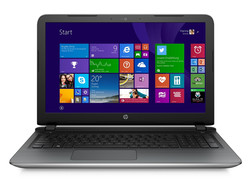
The notebook that is more susceptible to damage and with weaker build quality can be quickly crossed off of our list. Unfortunately for Lenovo, this means it is more difficult for us to recommend the IdeaPad Z50 over the Pavilion 15 or Satellite S50. It may have a marginally better display and a useful VGA port, but its problems are difficult to ignore including its low battery life and poor keyboard.
For a standard no-frills notebook without a four-digit price range, the Pavilion 15 and Satellite S50 are good choices. However, the lighter of the two notebooks has the much shorter battery life than the other, so none of these models are ideal for the frequent traveler. For home and indoor use, the Pavilion 15 gets the small edge over the Toshiba for its accessibility and balanced keyboard.
| HP Pavilion 15 2015 | Lenovo IdeaPad Z50 | Toshiba Satellite S50 |
|---|---|---|
+ Stronger chassis + Matte panel + Nvidia graphics + Longer battery life + Lower surface temperatures | + Lower fan noise + Higher contrast + VGA port | + Stronger chassis + Thinner and lighter + Solid touchpad |
- Higher fan noise - No Gigabit Ethernet - Higher CPU temperatures - Lower contrast | - Heavier - Dual Graphics - Poor keyboard and touchpad - Weaker chassis - Poorer battery life - Glossy panel could be brighter | - No Optical drive - More difficult maintenance - Glossy panel could be brighter - Uneven keyboard feedback - SATA II only - Higher surface temperatures |
See More Quick Comparisons In Our Face Off Series:
- Dell XPS 15 vs. Apple MacBook Pro 15 vs. Asus ZenBook Pro UX501
- Aorus X3 Plus vs. Gigabyte P34W vs. Razer Blade 14
- Dell XPS 13 vs. Apple MacBook Pro 13 vs. Asus ZenBook UX305
- HP EliteBook 820 G2 vs. Lenovo ThinkPad X250 vs. Dell Latitude 12 E7250
- Asus ROG G751 vs. Dell Alienware 17 vs. MSI GT72 Dominator
- Lenovo ThinkPad T450 vs. Acer TravelMate P645 vs. Dell Latitude 14 E5450
- Dell Alienware 15 vs. Clevo P751ZM vs. MSI GE62
- Acer Aspire V17 Nitro vs. Asus N751 vs. HP Envy 17
- Samsung Galaxy Tab S 8.4 vs. Sony Xperia Z3 Compact vs. Dell Venue 8 7000
- Asus EeeBook X205TA vs. Lenovo S20 vs. Acer Aspire ES1
- Microsoft Surface Pro 3 vs. Asus Transformer Book T300 Chi vs. Toshiba Portege Z20t
- Lenovo ThinkPad Edge E550 vs. Acer Aspire E5 vs. HP ProBook 450 G2




